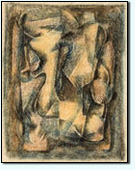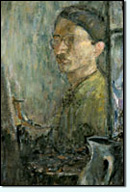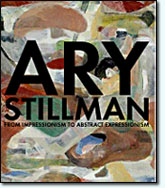Publications
Reminiscences > We Return to Paris (1955-1956)
My optimistic hopes for the effects of Paris on Ary's physical and emotional state proved wrong in every way. The high blood pressure and over-wrought nerves and the despairing sense of displacement became worse rather than better. Our room at the Lutece was small and uncomfortable. The crowds at the cafes didn't talk about art anymore; they talked about dealers and the best ways to sell. And they were bitter against America and Americans.
Of course Paris still retained its charms —"This afternoon we walked to Arbit Blatas' studio. Sun-drenched avenues, lined with rows of green trees — wonderful abstractions. Paris began to creep into our hearts again." (From Frances diary.)
But Ary brooded constantly over the loss of our studio and our homelessness. There was no desire for adventure in the new situation; there was only mourning over what had been lost, and hopelessness for the future. A visit to a doctor, a friend of Ary's former years in Paris, showed his blood pressure alarmingly high and his entire physical condition most unsatisfactory. Also it was generally cold and wet in Paris, and the doctor suggested that we go to a milder climate. We finally settled on Majorca. A Spanish painter named Ramis whom we met at one of the cafes told us of his hometown in Majorca — a town not far from Palma called Soler. It was set in the mountains, and an electric tram led down to a beach on the sea. It was quiet and picturesque, he said, better for us than Palma. So about the middle of May we set out for Majorca.
Soler proved to be a French-speaking town. Many of the inhabitants had spent many years in France, in or near Marseilles, as fruit importers; they had made money and then when they had amassed enough to set themselves up in business in their homeland, they had returned to Majorca. So Ary felt in his element, as far as communication was concerned. Also, most of the guests at the pension in which we installed ourselves were Belgians, and even I found myself able to join in conversation with them.
The square was dominated by a big white stone church, Gothic Renaissance, with Moorish-type decoration, and was lined with shops and outdoor cafes, with a big stone fountain in the middle, and further down the street a trough, where drivers of carts brought their horses, donkeys, mules, and even an ox to drink. Children gathered around the fountain. People rode by in autos, motorcycles, scooters, bicycles, and in contrast an old man carrying a jug would walk slowly down the sloping street to the water fountain, fill the jug and carry it up the hill again, balanced on his back.
Naturally this scene appealed to Ary, and we spent many hours at the cafes on the square, drinking coffee or occasionally cognac, which was only about ten cents a glass in our money. He loved the beach, too, and almost every afternoon about five o'clock, after the burning heat of midday had subsided, we would take the streetcar from the square down a winding trail in the mountains, to the beach below. A number of hotels were situated on the beach, and they had tables and chairs and beach umbrellas lining the waterfront. The beach was rocky and the water dirty, but Ary loved it, and he would happily wade into the water — really a funny spectacle, in his red and white plaid bathing trunks, and still wearing his bone-rimmed glasses and a big-brimmed straw hat on his head. Returning refreshed to the pension, we would eat a light supper, and then sit on the verandah, watching the lights of the little electric train from Palma as it wound its way through the mountains, and talking to our fellow-guests.
Ary's physical condition had improved, and on the surface his morale was better. But on July 5th there is an entry in the diary, which I kept sporadically :
"An unhappy day. I am worried about Ary. He surely is better physically, but his sense of bewilderment, his inability to adjust to the loss of the 59th Street studio, are pitiful and terribly discouraging. It seems that all our dreams, all our plans during these years, have gone sour. The dreaming and the planning were the reality, it seems, and the realization is something very empty. I still resist this disappointing denouement, and must fight for something better for us both.''
However, on July 8th I made the following entry:
"Ary started to paint again yesterday, and is working on several little canvases. I stay in the room while he works, and study my French. It has always been one of my greatest joys to be near him while he works. His canvases are fresh and interesting in color and form. I have my fingers crossed and hope he will go on to retain his old interest and joy of accomplishment."
And again the next day:
"Ary did a beautiful canvas this morning, in greens and grays and black, directly on the base canvas, without a background layer. I think it is quite stunning just 'as is.' "
“The largest of the three, "Majorca," seems to reflect the merciless heat of the Majorcan sun. Sometime in the 60s Ary worked on it a bit, and although he probably improved it structurally, I think he lost something of the brilliant red which conveyed the feeling of the burning sunlight.”
The Majorcan stay produced three small canvases. A small structural composition in black, green and yellow must be the one I mentioned in my diary. Unsigned, it is listed as Abstraction No. 105, in the Foundation records. No. 102, also unsigned, I called at the time it was painted "Crucifixion." As I look at it now, it seems to me that it presages to some extent Ary's Mexican series of fantasy figures. The largest of the three, "Majorca," seems to reflect the merciless heat of the Majorcan sun. Sometime in the 60s Ary worked on it a bit, and although he probably improved it structurally, I think he lost something of the brilliant red which conveyed the feeling of the burning sunlight.
By late July I was able to write:
"Ary is getting more and more into the swing of painting, and is talking of concentrating for a long period, buying a number of canvases as soon as the store here has a new stock, and more and more he leans toward the idea of remaining here for the fall and perhaps part of the winter."
But I could sense that the new interest was for the most part a cover-up of his underlying unhappiness. And we received conflicting reports about the severity of the Majorcan winters, and of course the houses weren't heated. Nevertheless we began to look around for a house. One was for sale for $1,000 — a sturdily built, two-story structure; drawback: it had no running water. The Majorcans told us we could have a maid who would carry water to the house every day, but I was afraid of this. Finally we decided on a three-story house just off the square. The painter Jacques Zucker and his wife had been occupying it for the summer. It had a bathroom and running water on each floor, and a good studio room on the top floor. No electric refrigerator, of course, and only an oil stove. The rent was $17 a month. We were just about to sign a lease when one evening at supper time the little maid at the pension brought an envelope to our table. It was a cable from Paris. My friend Martin Panzer, with whom I had worked at the State of Israel Bond office in New York and who was now in charge of the European drive, had lost his assistant, and wanted to know if I would like to come to Paris to take the job. Ary and I talked it over that evening and the following morning I sent Martin a return cable saying that we would come to Paris.

The Studio
1956, oil on canvas
39 1/4 x 28 5/8 in.,
[Virginia Museum of Fine Arts, VA]
In Paris we put up at the Lutece, and Ary found a room nearby that he could use as a studio. It was bare and cold, and the only room they could give us at the hotel was tiny and dark, and in general we were miserable. Finally Ary met the painter Joseph Floch at the cafe. Floch was leaving for the United States and wanted to sublet his studio until June. Ary grabbed it up. It was, like so many Paris studios, one of a row of buildings in an alleyway; one room, with tremendously tall sloping ceiling and a skylight. Floch had been using it as living quarters, but we decided I couldn't stand it even if Ary could. It had running water, but no inside toilet, and the only means of heating was an old stove in the center of the room. So we found sleeping quarters at the Hotel de Chatillon, a block or two away. The winter was very cold and Ary found that he had to tussle with the stove all morning to get it to burn. Meanwhile he would wrap himself up in a blanket and stretch out on the couch, listening to lectures from the Sorbonne on the radio. By the time the studio was halfway warm, Ary had neither the energy nor the inclination to paint. But one canvas did emerge from that period, a large painting that Ary called "The Studio." It is an abstraction, and it gives the impression of fireplace and easels and light streaming in from above.
“There, despite his precarious physical condition, Ary found peace and relaxation, and as a result one of his finest series of charcoal and pastel drawings — the series dealing particularly with space and light—was evolved.”
Meanwhile Ary's blood pressure had shot up alarmingly, and nothing the doctors could do for him seemed to help. He really made a valiant effort to pull himself together, but the trouble now was physical more than emotional, and he was in really bad shape.
The following spring an artist friend of Ary's named Boberman offered to sublet us his studio for the summer. It was the typical old studio, one room, very high ceilinged, with a narrow stairway leading up to a balcony, where there was a bed, a few pieces of furniture, and (a modern addition) a bathroom. The Boberman's had furnished it quite charmingly, with a Spanish table and candelabras and other wrought-iron pieces. And it had an electric ice-box and a gas stove, so we could prepare our meals. The location was ideal, across the street from the Gare Montparnasses, in the alleyway where a tiny theatre "Le Theatre de Poche" was housed. There, despite his precarious physical condition, Ary found peace and relaxation, and as a result one of his finest series of charcoal and pastel drawings — the series dealing particularly with space and light—was evolved.
All this time we had been looking for a studio of our own to rent or to buy, but there was nothing at all available. Paris was overcrowded, there was little building going on, and professional and business people were buying up all the studio apartments. The coming winter loomed before us frighteningly. So finally after much deliberation, we decided to give up the idea of a home in Paris, and the first week in November found us on the Liberte sailing for home.
We both realized that Ary couldn't take the New York tempo anymore, and when a letter came to us at the hotel in New York from Ary's sister Sarah Lack in Houston, begging us to come down there, we decided to accept her invitation for the winter. Ary didn't care for the city as an environment, but Mexico was nearby and he felt that when the summer came, we could make for that country, which he had found so delightful back in 1940.
Copyright © 2002-2007 The Stillman-Lack Foundation.
All text and images on this site may not be published, broadcast, or distributed in any form without the prior written permission of The Stillman-Lack Foundation.





